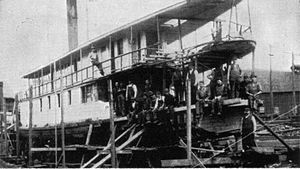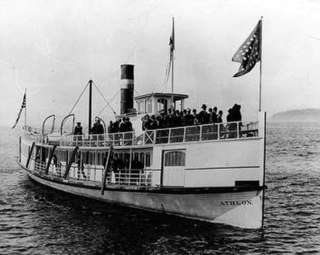
Athlon was a typical passenger steamboat of the Puget Sound Mosquito Fleet.

The steamboat Fortuna was a vessel that operated on Lake Washington in the first part of the 20th century.

The steamboat Defiance operated in the early 1900s as part of the Puget Sound Mosquito Fleet. In later years this vessel was called Kingston.

The steamboat Monticello (2) operated in the early 1900s as part of the Puget Sound Mosquito Fleet. The vessel went through several reconstructions and remained in service until 1962, when she was lost in Alaska waters. Her later names were Penaco and Sea Venture. (This Puget Sound steamer should not be confused with the smaller Monticello, which also ran on Puget Sound, but was built in 1895 for Captain Z.J. Hatch of the Monticello Steamship Company.

The steamboat George E. Starr operated in late 19th century as part of the Puget Sound Mosquito Fleet and also operated out of Victoria, B.C. Geo. E. Starr also served for a time in California and on the Columbia River.

The steamboat Rosalie operated from 1893 to 1918 as part of the Puget Sound Mosquito Fleet, also operating out of Victoria, B.C. In 1898, Rosalie went north with many other Puget Sound steamboats to join the Klondike Gold Rush.

The Greyhound was an express passenger steamer that operated from the 1890s to about 1915 on Puget Sound in Washington, United States. This vessel, commonly known as the Hound, the Pup, or the Dog, was of unusual design, having small upper works, but an enormous sternwheel. Unlike many sternwheelers, she was not intended for a dual role as passenger and freighter, but was purpose-built to carry mostly passengers on express runs.

Flyer was an American steamboat that served from 1891 to 1929 on Puget Sound. From 1918 until the end of her service, she was officially known as the Washington. The Flyer ran for millions of miles at high speed, more than any inland vessel in the world. This 1891 steamer Flyer should not be confused with the steamboat Flyer built on Lake Coeur d'Alene in 1905, although the Coeur d'Alene vessel was inspired both in design and name by the success of the Puget Sound ship.
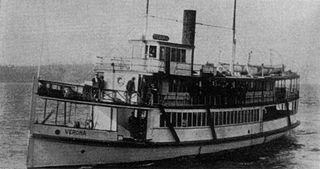
The steamship Verona was a small steamboat of the Puget Sound Mosquito Fleet.

Fairhaven was a sternwheel steamboat of the Puget Sound Mosquito Fleet which operated from 1889 to 1918.
The Kitsap County Transportation Company was an important steamboat and ferry company that operated on Puget Sound. The company was founded in 1898 as the Hansen Transportation Company.

Lady of the Lake was a wooden steamboat that operated on Puget Sound from 1897 to 1903. Following a fire in 1903, the vessel was rebuilt as the tug Ruth.
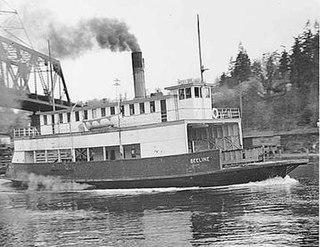
Florence K was a steamboat that was operated on Puget Sound from 1903. This vessel was later renamed Gloria and was rebuilt as a steam ferry and renamed Beeline.

C.C. Calkins was a small steamboat built in 1890 which served on Lake Washington.

Sioux was a steamship which was operated on Puget Sound and the Strait of Juan de Fuca from 1912 to 1941. From 1924 to 1941, following reconstruction, the vessel operated as an auto ferry under the name Olympic. During the Second World War (1941-1945) this vessel was taken under the control of the U.S. Army and renamed the Franklin R. Leisenburg. The Liesenburg served as a ferry in the Panama Canal area under Army control, and then was sold to a firm which ran the vessel on the Surinam river in South America.
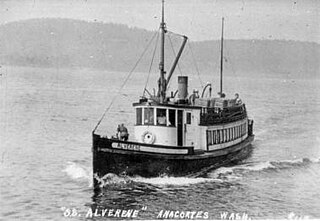
Alverene was a gasoline launch built in 1912 which operated on northern Puget Sound and in the San Juan Islands.

Atlanta was a steamboat built in 1908 at Houghton, Washington which served on Lake Washington and Puget Sound until 1938, when it was converted into a diesel-powered houseboat.

Suquamish, built in 1914, was the first diesel-engined passenger vessel in the United States. Much later Suquamish was converted to a commercial fishing vessel and was registered as a Canadian vessel under the name Terry.

Speeder was a motor launch built in 1908 which served on Puget Sound and in the San Juan Islands. From 1908 to 1922 this vessel was named Bainbridge.
